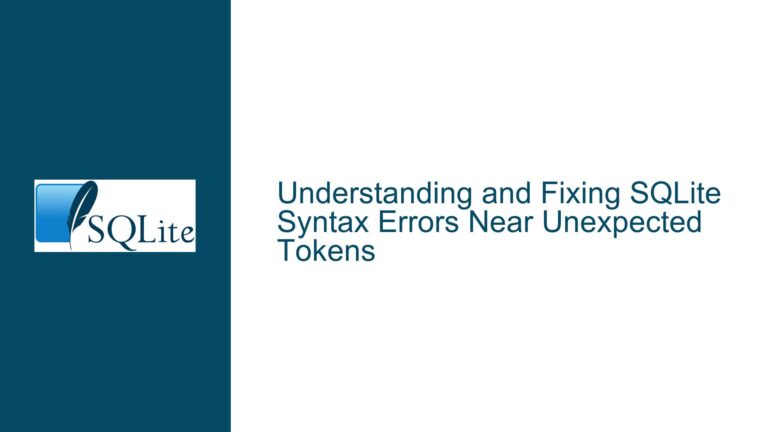Implementing eBook Content Search with SQLite FTS5: Challenges and Solutions
Evaluating FTS5 for eBook Search Requirements
The core challenge revolves around leveraging SQLite’s FTS5 module to enable efficient full-text search within eBooks, where the primary goals are:
- Accurate Location Tracking: Identifying the exact position (e.g., byte offset, paragraph number) of search results within a book.
- Snippet Generation: Extracting contextual text snippets around matches for user-friendly previews.
- Scalability: Handling large volumes of text across multiple eBooks without degrading performance.
FTS5 is designed for full-text indexing and querying, but eBook search introduces unique constraints. Unlike web pages or documents, eBooks often require granular location tracking (e.g., chapter, page, or paragraph offsets) and context-aware snippet generation. The module’s ability to map search results back to their original positions in the source text is critical.
A typical eBook search workflow involves:
- Splitting books into searchable units (e.g., paragraphs, pages).
- Indexing these units in an FTS5 virtual table.
- Linking indexed text to metadata (e.g., book title, author) and positional data (e.g., file offsets).
- Querying the index and reconstructing results with snippets and locations.
The complexity arises from balancing FTS5’s tokenization rules, schema design for positional tracking, and performance optimizations for large datasets.
Common Pitfalls in FTS5-Based eBook Search Architectures
Inadequate Text Segmentation
- FTS5 operates on rows, so improper segmentation (e.g., indexing entire books as single rows) prevents accurate snippet generation. Without paragraph-level granularity, snippets may span irrelevant text.
- Example: A 1,000-page book stored as one FTS5 row forces snippet extraction from the entire text, slowing queries and reducing relevance.
Misaligned RowID Relationships
- FTS5 allows explicit
rowidassignment, but mismanaging the link between FTS5 entries and positional metadata (e.g., paragraph offsets) breaks result accuracy. - Example: Inserting paragraphs into FTS5 without synchronizing
rowidwith aparagraphtable’sparaidleads to incorrect file positions in search results.
- FTS5 allows explicit
Tokenizer Limitations
- FTS5’s default tokenizer splits text into ASCII alphanumeric sequences, which may mishandle hyphenated words, accented characters, or non-Latin scripts common in eBooks.
- Example: Searching for "naïve" fails if the tokenizer strips diacritics, or "mother-in-law" is indexed as three separate tokens.
Performance Bottlenecks
- Large eBook corpora strain FTS5’s in-memory index structures. Queries over millions of paragraphs may degrade without proper indexing strategies.
- Example: A query for "the" in a library of 10,000 books returns millions of matches, overwhelming the query engine.
Snippet Context Mismanagement
- The
snippet()function’s output depends on the indexed text’s structure. Poorly segmented text produces snippets lacking meaningful context. - Example: A snippet spanning multiple paragraphs due to coarse segmentation confuses users.
- The
Structured Approach to eBook Search Implementation
Step 1: Schema Design for Positional Tracking
Create a relational structure to map FTS5 entries to eBook locations:
-- Books metadata
CREATE TABLE book (
book_id INTEGER PRIMARY KEY,
title TEXT NOT NULL,
author TEXT NOT NULL,
file_path TEXT UNIQUE NOT NULL
);
-- Paragraphs with positional data
CREATE TABLE paragraph (
para_id INTEGER PRIMARY KEY,
book_id INTEGER NOT NULL REFERENCES book,
start_offset INTEGER NOT NULL, -- Byte offset in the eBook file
end_offset INTEGER NOT NULL
);
-- FTS5 index over paragraph text
CREATE VIRTUAL TABLE book_search USING fts5(
content='paragraph',
content_rowid='para_id',
body_text -- Explicit column name for clarity
);
- Why This Works: Each paragraph is indexed as a separate FTS5 row, enabling precise snippet extraction. The
paragraphtable tracks byte offsets in the source file, allowing direct navigation to matches.
Step 2: Tokenizer Customization
Configure FTS5 to handle eBook text nuances:
CREATE VIRTUAL TABLE book_search USING fts5(
body_text,
tokenize='unicode61 remove_diacritics 2',
prefix='2 3 4' -- Index prefixes for wildcard queries
);
- Tokenization Adjustments:
unicode61: Supports Unicode characters, critical for multilingual eBooks.remove_diacritics 2: Strips accents (é → e) but retains case sensitivity.prefix: Indexes 2-, 3-, and 4-character prefixes for partial word matches (e.g., "te*" finds "test").
Step 3: Data Population Workflow
Extract paragraphs from eBooks and populate tables atomically:
-- Insert book metadata
INSERT INTO book (title, author, file_path)
VALUES ('The Time Machine', 'H.G. Wells', '/books/time_machine.epub');
-- Extract paragraphs (pseudo-code)
FOR each paragraph IN ebook:
INSERT INTO paragraph (book_id, start_offset, end_offset)
VALUES (last_insert_rowid(), para.start, para.end);
INSERT INTO book_search (rowid, body_text)
VALUES (last_insert_rowid(), para.text);
- Atomic Inserts: Using
last_insert_rowid()ensuresbook_search.rowidmatchesparagraph.para_id, maintaining alignment.
Step 4: Querying with Snippets and Locations
Join FTS5 results with metadata and positional data:
SELECT
b.title,
p.start_offset,
snippet(book_search, 0, '[', ']', '...', 16) AS snippet
FROM book_search
JOIN paragraph p ON p.para_id = book_search.rowid
JOIN book b ON b.book_id = p.book_id
WHERE book_search MATCH 'time travel'
ORDER BY b.title;
- Snippet Customization:
snippet()arguments highlight matches with[and], truncate long context with..., and limit snippet length to 16 tokens.
Step 5: Performance Optimization
Contentless FTS5 Tables: Store text externally to reduce index size:
CREATE VIRTUAL TABLE book_search USING fts5( body_text, content='', content_rowid='para_id' );- Trade-off: Requires joining with
paragraphto retrieve text, but speeds up index updates.
- Trade-off: Requires joining with
Batch Insertions and Transactions:
BEGIN TRANSACTION; -- Bulk insert paragraphs COMMIT;- Reduces disk I/O overhead during large data imports.
Step 6: Handling Proximity and Phrase Queries
FTS5’s NEAR operator enhances relevance for multi-term queries:
SELECT snippet(book_search)
FROM book_search
WHERE body_text MATCH 'time NEAR/5 machine'; -- Terms within 5 tokens
- Limitation: FTS5 does not support true phrase search (fixed-term order). Use
NEAR/0for exact phrases.
Step 7: Mitigating Tokenization Edge Cases
- Custom Tokenizers: For languages with complex morphology (e.g., German compounds), use SQLite’s
fts5tokenizeAPI to implement a custom tokenizer. - Synonym Expansion: Extend queries dynamically:
WHERE body_text MATCH '("database" OR "DB")'
Step 8: Validation and Debugging
- Query Diagnostics: Use
fts5vocabto inspect indexed terms:SELECT term, doc FROM fts5vocab('book_search', 'row') WHERE term LIKE 'time%'; - Offset Mismatch Detection:
-- Detect paragraphs missing in FTS5 SELECT para_id FROM paragraph WHERE para_id NOT IN (SELECT rowid FROM book_search);
This guide provides a comprehensive roadmap for implementing eBook search with SQLite FTS5, addressing segmentation, tokenization, performance, and result reconstruction. By aligning FTS5’s capabilities with eBook-specific requirements, developers can achieve scalable and accurate search functionality.






